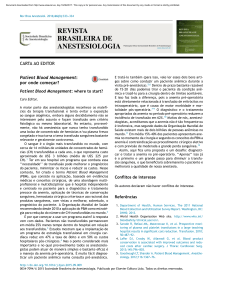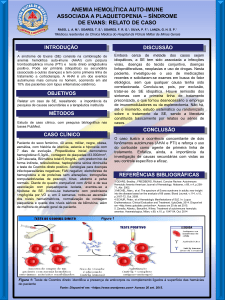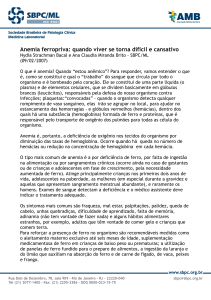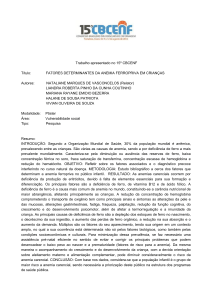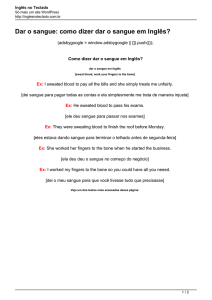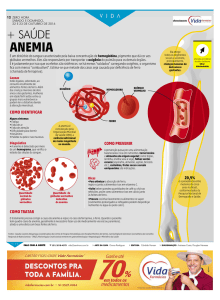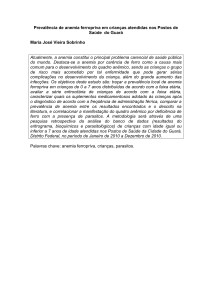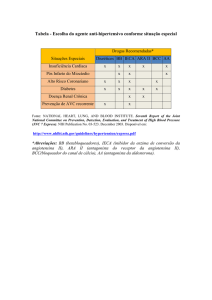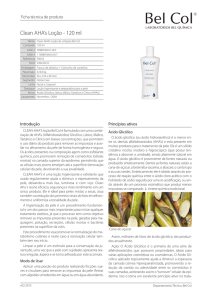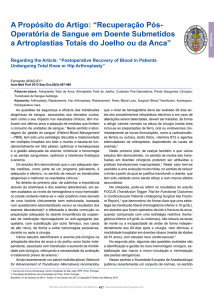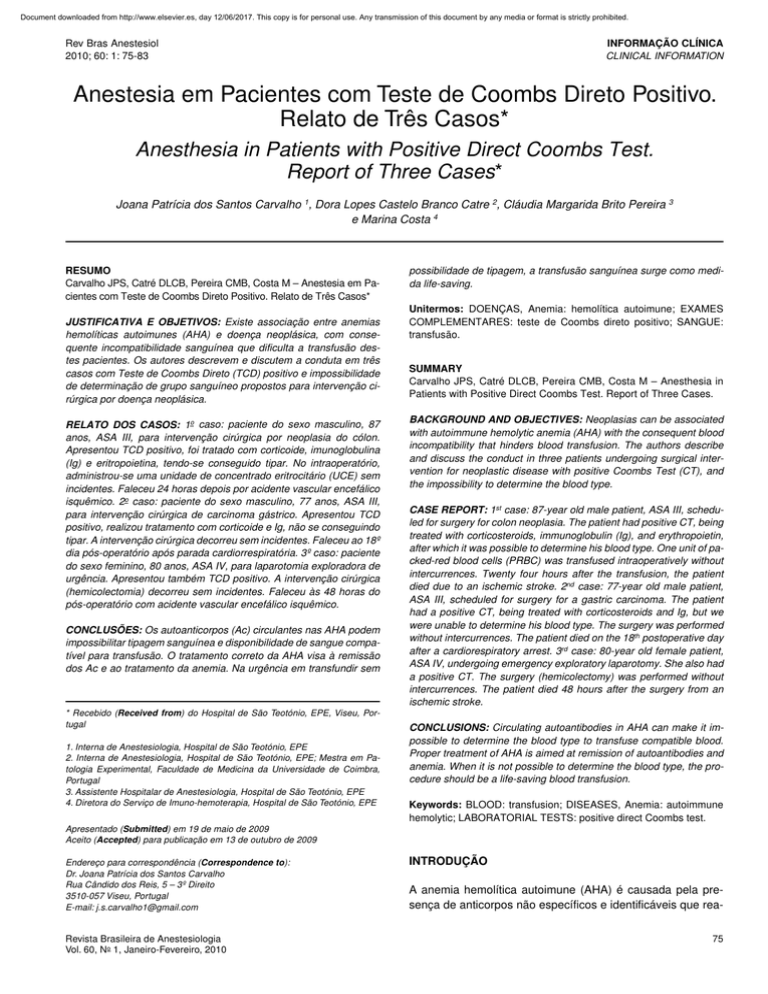
Document downloaded from http://www.elsevier.es, day 12/06/2017. This copy is for personal use. Any transmission of this document by any media or format is strictly prohibited.
Rev Bras Anestesiol
2010; 60: 1: 75-83
INFORMAÇÃO CLÍNICA
CLINICAL INFORMATION
Anestesia em Pacientes com Teste de Coombs Direto Positivo.
Relato de Três Casos*
Anesthesia in Patients with Positive Direct Coombs Test.
Report of Three Cases*
Joana Patrícia dos Santos Carvalho 1, Dora Lopes Castelo Branco Catre 2, Cláudia Margarida Brito Pereira 3
e Marina Costa 4
RESUMO
Carvalho JPS, Catré DLCB, Pereira CMB, Costa M – Anestesia em Pacientes com Teste de Coombs Direto Positivo. Relato de Três Casos*
JUSTIFICATIVA E OBJETIVOS: Existe associação entre anemias
hemolíticas autoimunes (AHA) e doença neoplásica, com consequente incompatibilidade sanguínea que dificulta a transfusão destes pacientes. Os autores descrevem e discutem a conduta em três
casos com Teste de Coombs Direto (TCD) positivo e impossibilidade
de determinação de grupo sanguíneo propostos para intervenção cirúrgica por doença neoplásica.
RELATO DOS CASOS: 1o caso: paciente do sexo masculino, 87
anos, ASA III, para intervenção cirúrgica por neoplasia do cólon.
Apresentou TCD positivo, foi tratado com corticoide, imunoglobulina
(Ig) e eritropoietina, tendo-se conseguido tipar. No intraoperatório,
administrou-se uma unidade de concentrado eritrocitário (UCE) sem
incidentes. Faleceu 24 horas depois por acidente vascular encefálico
isquêmico. 2o caso: paciente do sexo masculino, 77 anos, ASA III,
para intervenção cirúrgica de carcinoma gástrico. Apresentou TCD
positivo, realizou tratamento com corticoide e Ig, não se conseguindo
tipar. A intervenção cirúrgica decorreu sem incidentes. Faleceu ao 18º
dia pós-operatório após parada cardiorrespiratória. 3º caso: paciente
do sexo feminino, 80 anos, ASA IV, para laparotomia exploradora de
urgência. Apresentou também TCD positivo. A intervenção cirúrgica
(hemicolectomia) decorreu sem incidentes. Faleceu às 48 horas do
pós-operatório com acidente vascular encefálico isquêmico.
CONCLUSÕES: Os autoanticorpos (Ac) circulantes nas AHA podem
impossibilitar tipagem sanguínea e disponibilidade de sangue compatível para transfusão. O tratamento correto da AHA visa à remissão
dos Ac e ao tratamento da anemia. Na urgência em transfundir sem
* Recebido (Received from) do Hospital de São Teotónio, EPE, Viseu, Portugal
1. Interna de Anestesiologia, Hospital de São Teotónio, EPE
2. Interna de Anestesiologia, Hospital de São Teotónio, EPE; Mestra em Patologia Experimental, Faculdade de Medicina da Universidade de Coimbra,
Portugal
3. Assistente Hospitalar de Anestesiologia, Hospital de São Teotónio, EPE
4. Diretora do Serviço de Imuno-hemoterapia, Hospital de São Teotónio, EPE
possibilidade de tipagem, a transfusão sanguínea surge como medida life-saving.
Unitermos: DOENÇAS, Anemia: hemolítica autoimune; EXAMES
COMPLEMENTARES: teste de Coombs direto positivo; SANGUE:
transfusão.
SUMMARY
Carvalho JPS, Catré DLCB, Pereira CMB, Costa M – Anesthesia in
Patients with Positive Direct Coombs Test. Report of Three Cases.
BACKGROUND AND OBJECTIVES: Neoplasias can be associated
with autoimmune hemolytic anemia (AHA) with the consequent blood
incompatibility that hinders blood transfusion. The authors describe
and discuss the conduct in three patients undergoing surgical intervention for neoplastic disease with positive Coombs Test (CT), and
the impossibility to determine the blood type.
CASE REPORT: 1st case: 87-year old male patient, ASA III, scheduled for surgery for colon neoplasia. The patient had positive CT, being
treated with corticosteroids, immunoglobulin (Ig), and erythropoietin,
after which it was possible to determine his blood type. One unit of packed-red blood cells (PRBC) was transfused intraoperatively without
intercurrences. Twenty four hours after the transfusion, the patient
died due to an ischemic stroke. 2nd case: 77-year old male patient,
ASA III, scheduled for surgery for a gastric carcinoma. The patient
had a positive CT, being treated with corticosteroids and Ig, but we
were unable to determine his blood type. The surgery was performed
without intercurrences. The patient died on the 18th postoperative day
after a cardiorespiratory arrest. 3rd case: 80-year old female patient,
ASA IV, undergoing emergency exploratory laparotomy. She also had
a positive CT. The surgery (hemicolectomy) was performed without
intercurrences. The patient died 48 hours after the surgery from an
ischemic stroke.
CONCLUSIONS: Circulating autoantibodies in AHA can make it impossible to determine the blood type to transfuse compatible blood.
Proper treatment of AHA is aimed at remission of autoantibodies and
anemia. When it is not possible to determine the blood type, the procedure should be a life-saving blood transfusion.
Keywords: BLOOD: transfusion; DISEASES, Anemia: autoimmune
hemolytic; LABORATORIAL TESTS: positive direct Coombs test.
Apresentado (Submitted) em 19 de maio de 2009
Aceito (Accepted) para publicação em 13 de outubro de 2009
Endereço para correspondência (Correspondence to):
Dr. Joana Patrícia dos Santos Carvalho
Rua Cândido dos Reis, 5 – 3º Direito
3510-057 Viseu, Portugal
E-mail: [email protected]
Revista Brasileira de Anestesiologia
Vol. 60, No 1, Janeiro-Fevereiro, 2010
INTRODUÇÃO
A anemia hemolítica autoimune (AHA) é causada pela presença de anticorpos não específicos e identificáveis que rea75
Document downloaded from http://www.elsevier.es, day 12/06/2017. This copy is for personal use. Any transmission of this document by any media or format is strictly prohibited.
CARVALHO, CATRE, PEREIRA E COL.
gem com antígenos de superfície dos glóbulos vermelhos.
A anemia aparece quando a porcentagem de destruição dos
glóbulos vermelhos excede a capacidade regenerativa da
medula óssea. Na hemólise autoimune, o revestimento dos
autoanticorpos não danifica os glóbulos vermelhos, mas causa a hemólise por ativação do complemento, induzindo interações com o sistema mononuclear fagocítico.
Existe associação entre anemias hemolíticas autoimunes
(AHA) e doença neoplásica, com consequente incompatibilidade sanguínea que dificulta a transfusão destes pacientes.1
A natureza da evolução clínica das AHA e as modalidades do
tratamento incluem a terapêutica transfusional.2
O teste de Coombs ou Antiglobulina Direta (TAD) constitui
método elementar e simples para demonstração da presença de IgG e/ou complemento revestindo a superfície
dos eritrócitos in vivo. A utilização do TAD é mais apropriada no estudo das anemias hemolíticas em que se suspeite
de origem imune. Se positivo, tem elevado valor preditivo de
origem imune em um paciente com anemia hemolítica. No
entanto, a presença de TAD positivo não significa, necessariamente, que um indivíduo tenha anemia hemolítica,
sendo, por vezes, positivo em indivíduos hematologicamente normais.3
Em pacientes com AHA, definida pela curta duração dos glóbulos vermelhos em razão da resposta humoral autoimune
associada à TAD positivo, aloanticorpos e, possivelmente,
autoanticorpos dificultam a determinação de sangue compatível, face à necessidade de transfusão. Nesses pacientes, a
terapia transfusional pode ser desastrosa e condicionar sérios efeitos deletérios.3
O objetivo deste relato foi descrever e discutir a conduta em
três casos com Teste de Coombs Direto (TCD) positivo e impossibilidade de determinação de grupo sanguíneo propostos
para intervenção cirúrgica por doença neoplásica.
RELATO DOS CASOS
A Tabela I resume a evolução e a abordagem dos três casos
clínicos.
CASO 1
Paciente do sexo masculino, 78 anos de idade, sem doenças
conhecidas, sem transfusões anteriores ou procedimentos
anestésico-cirúrgicos prévios. Foi proposto para laparotomia
exploradora programada, por neoplasia do cólon. Clinicamente apresentava anemia (hemoglobina de 8,8 g.dL-1), com TAD
positivo (Ig3+), impossibilitando a determinação do grupo
sanguíneo. Foi medicado com ferro, eritropoietina, imunoglobulina e corticoide e, após cinco dias de tratamento, foi conseguida a determinação do grupo sanguíneo O, Rh negativo.
Classificado como ASA III.
A intervenção cirúrgica (colostomia) foi realizada sob anestesia geral balanceada com duração de 60 minutos. Por perdas
hemorrágicas, com compromisso hemodinâmico, foi administrada uma unidade de concentrado de eritrócitos (CE). O con76
trole analítico pós-tranfusional mostrou hemoglobina de 9,0
g.dL-1. Durante os 120 minutos de permanência na Unidade
de Cuidados Pós-Anestésicos (UCPA), o paciente manteve
estabilidade hemodinâmica.
Na enfermaria, quatro horas após alta da UCPA, desenvolveu estado comatoso (Escala de Coma de Glasgow de 4)
associado a agravamento da anemia (hemoglobina de 7
g.dL-1, hematócrito de 20%). Faleceu às 24 horas do pósoperatório com o diagnóstico de acidente vascular encefálico isquêmico.
CASO 2
Paciente do sexo masculino, 77 anos de idade, sem antecedentes transfusionais ou de procedimentos anestésico-cirúrgicos, proposto para gastrectomia programada, por adenocarcinoma gástrico.
Apresentava fibrilação atrial (FA) e hipertensão arterial (HA),
controladas clinicamente. Classificado como ASA III.
Analiticamente, apresentava hemoglobina (Hb) de 14,0 g.dL-1
e trombocitopenia de 55 × 109 plaquetas.L-1. Por apresentar
TAD positivo (Ig4+) realizou, também, tratamento com corticoide e imunoglobulina durante 25 dias, não se conseguindo
tipar o grupo sanguíneo.
Foi submetido à anestesia geral balanceada e, durante o procedimento cirúrgico, foi transfundido com seis unidades de
plaquetas, por hemorragia em toalha (hemorragia venosa –
nota do revisor). A intervenção cirúrgica teve duração de 150
minutos.
Durante os 120 minutos que permaneceu na UCPA, manteve a estabilidade hemodinâmica, tendo o controle analítico revelado 12,8 g.dL-1 de hemoglobina e 80 × 109
plaquetas.L-1.
Ao 9º dia pós-operatório, verificou-se descida da hemoglobina para 8,5 g.dL-1 com trombocitopenia de 20 × 109
plaquetas.L-1, tendo sido transfundido com mais cinco unidades de plaquetas.
Faleceu ao 18º dia do pós-operatório, após agravamento progressivo do estado geral.
CASO 3
Paciente do sexo feminino de 80 anos de idade, com o diagnóstico de abdômen agudo, proposta para laparotomia exploradora de urgência.
Clinicamente, apresentava antecedentes de cardiopatia isquêmica, FA e HA medicadas. Três semanas antes do quadro clínico que motivou a vinda à urgência, tinha sido transfundida com três unidades de CE por apresentar uma Hb de
7,2 g.dL-1. Classificada como ASA IV.
À entrada, apresentava-se muito queixosa, com sinais de
má-perfusão periférica e taquiarritmia por FA (140 bpm) que
foi controlada com amiodarona e digitálico. Analiticamente,
apresentava anemia de 9 g.dL-1, insuficiência renal (ureia 57
mg.dL-1 e creatinina 1,9mg.dL-1) e TAD positivo (Ig4+), não se
conseguindo determinar o grupo sanguíneo.
Foi submetida à hemicolectomia (por tumor cólico obstruRevista Brasileira de Anestesiologia
Vol. 60, No 1, Janeiro-Fevereiro, 2010
Document downloaded from http://www.elsevier.es, day 12/06/2017. This copy is for personal use. Any transmission of this document by any media or format is strictly prohibited.
ANESTESIA EM PACIENTES COM TESTE DE COOMBS DIRETO POSITIVO. RELATO DE TRÊS CASOS
Permaneceu na UCPA durante três horas e meia mantendo a
estabilidade hemodinâmica e foi transferida para a enfermaria
consciente, minimamente colaborativa.
Faleceu às 48 horas pós-operatórias com acidente vascular
encefálico isquêmico.
tivo) sob anestesia geral balanceada com duração de 150
minutos. A paciente apresentou estabilidade hemodinâmica
durante a intervenção cirúrgica. O controle analítico pósoperatório revelou Hb de 7,7 g.dL-1, não tendo sido transfundida.
Tabela I – Evolução e Abordagem dos Três Casos Clínicos
Intervenção cirúrgica
Caso 1
Caso 2
Caso 3
Colostomia programada
Gastrectomia programada
Hemicolectomia de urgência
Clínica
Anemia
FA, HA
Cardiopatia isquêmica, FA, HA, IRC, anemia
Análises pré-operatórias
Hb 8,8 g.dL-1
TAD Ig3+
Hb 14,0 g.dL-1
TAD Ig4+
Hb 9,0 g.dL-1
TAD Ig4+
Terapêutica
Corticoterapia, imunoglobulina, ferro, eritopoietina
Grupo sanguíneo
O Rh positivo
Tipagem não conseguida
Tipagem não conseguida
Pré-operatória
–
–
3 unid de CE
Peroperatória
1 unid de CE
6 unid de plaquetas
–
Pós-operatória
–
5 unid de plaquetas
–
Transfusão
Hb 8,5
g.dL-1
Análises pós-operatórias
Hb 7,0
Pós-operatório
AVE isquêmico
Faleceu às 24 horas
g.dL-1
Hb 7,7 g.dL-1
Choque
Faleceu ao 18º dia
AVE isquêmico
Faleceu às 48 horas
TAD = teste de antiglobina direta (Coombs); FA = fibrilação atrial; IRC = insuficiência renal crônica; HA = hipertensão arterial; Hb = hemoglobina; CE = concentrado
de eritrócitos; AVE = acidente vascular encefálico.
Quadro I – Causas de Teste de Antiglobina Direta (Coombs) Positivo
Hemólise
Aloimune
• Doença hemolítica do
recém-nascido
• Reações hemolíticas
pós-transfusionais
Autoimune
• Idiopática
• Lúpus eritematoso sistêmico
• Síndrome de Evans
• Mononucleose infecciosa
• Hemoglobinúria paroxística ao frio
• Neoplasia linfo e mieloproliferativas:
leucemia linfocítica crônica e linfomas de
células B
• Transplante de órgãos e células
hematopoiéticas
• Leucemias agudas (raras)
• Doença de Hodgkin, linfomas não Hodgkin
• Macroglobulinemia de Waldenström
• Mieloma múltiplo
• Linfadenopatia angioimunoblástica
• Tumores sólidos (carcinomas): ovário,
mama, pulmão, cólon, pâncreas, rins, timo,
útero, testículos
• Sarcoma de Kaposi
Revista Brasileira de Anestesiologia
Vol. 60, No 1, Janeiro-Fevereiro, 2010
Induzida por fármacos
•
•
•
•
•
•
•
•
•
•
•
•
•
•
•
•
•
Alfa-metildopa
Penicilina
Quinidina
Procainamida
Análogos de purina
Isoniazida
Cefalosporinas
Tetraciclinas
Sulfonamidas
Estreptomicina
Rifampicina
Ampicilina
Anti-histamínicos
Insulina
Ibuprofeno
L-Dopa
Acetaminofeno
Outras
• Fatores técnicos
(procedimento usado na
colheita da amostra e
armazenamento)
• Sensibilidade do método
utilizado (em tubo, gel, fase
sólida etc.)
77
Document downloaded from http://www.elsevier.es, day 12/06/2017. This copy is for personal use. Any transmission of this document by any media or format is strictly prohibited.
CARVALHO, CATRE, PEREIRA E COL.
DISCUSSÃO
A anemia hemolítica autoimune (AHA) é, frequentemente, de
etiologia idiopática e pode ser complicação de doença neoplásica. A sua incidência é difícil de avaliar, porque quantidades mínimas de imunogloblulinas dos glóbulos vermelhos
podem permanecer indetectáveis sem o uso das técnicas especiais e a isoimunização após transfusão pode obscurecer
seu diagnóstico.
Porém, a AHA é doença bem-caracterizada, cujo diagnóstico baseia-se na demonstração da existência de hemólise e
no caráter autoimune desta destruição, conduzindo a grau
variável de anemia. A comprovação da existência de hemólise, definida como diminuição da sobrevida dos eritrócitos,
pode ser feita indiretamente com testes laboratoriais simples: determinação da bilirrubina sérica total e conjugada,
desidrogenase láctica (LDH), haptoglobinas e hemograma,
incluindo contagem de reticulócitos e esfregaço de sangue
periférico.
O TAD é teste com alto valor preditivo positivo relativamente
à etiologia imune da anemia hemolítica. No entanto, estão
descritos casos de AHA com TAD negativo.3
Da mesma forma que a ausência de TAD positivo não exclui
presença de AHA, também sua positividade, ainda que em
coexistência com anemia que pode ser devida a múltiplas
causas, não deve ser encarada imediatamente como sinônimo desta doença. O TAD pode ser positivo em pacientes
com estados infecciosos, sob tratamento de vários fármacos
ou sem significado clínico conhecido. Quando se detecta um
autoanticorpo com padrão de reatividade semelhante ao da
AHA, mas sem evidência de hemólise, provavelmente haverá outros fatores envolvidos que interferem com a atividade
do sistema macrofágico. Uma hipótese será que a depressão da atividade fagocitária do sistema macrofágico pode fazer com que um número de autoanticorpos suficientemente
elevado para ser detectado in vitro não tenha a capacidade
de provocar hemólise. Um exemplo frequente é o uso de
fármacos imunossupressores, nomeadamente corticoterapia; outro é a existência de doença autoimune, como o
lúpus eritematoso sistêmico, em que a presença de grandes quantidades de complexos imunes circulantes poderá
saturar os receptores macrofágicos, impedindo-os de retirar
eficazmente os eritrócitos da circulação. No entanto, esses
autoanticorpos podem ser encontrados em indivíduos saudáveis, nomeadamente em doadores de sangue, desconhecendo-se qualquer doença associada. A positividade pode
manter-se indefinidamente sem qualquer significado clínico,
regredir ou, em um pequeno número de casos, evoluir para
AHA.3
Metade das AHA secundárias à neoplasia é originada de
doenças linfoproliferativas, especialmente as de células B
(leucemia linfocítica crônica e linfomas). Existem, no entanto, outras neoplasias associadas a esse tipo de anemia2,4
(Quadro I).
Transfusões repetidas podem aumentar o risco de resposta aloimune, sendo a AHA potencial complicação da
78
transfusão de sangue alogênico, que surge concomitante
ou imediatamente após transfusão recente. Nesses casos,
recomenda-se tratamento de suporte com análogos do ferro e da eritropoietina, evitando a transfusão sempre que
possível.4,5
Infelizmente, o processo de preparação e seleção de sangue para os pacientes com AHA é moroso, intensivo, complicado e dispendioso, sendo raramente possível conseguir
sangue compatível mesmo quando se encontra uma especificidade. Geralmente, o melhor que um serviço de transfusão pode fazer, nos casos de urgência em que não há
tempo de se proceder aos testes sorológicos, é identificar
e oferecer as unidades de glóbulos vermelhos que são o
mais compatíveis possível com o sangue do paciente, mesmo que tais unidades possam não sobreviver na circulação. O ideal, entretanto, é dar sangue que seja compatível
com o grupo de sangue do paciente, à exceção naqueles
exemplos raros quando os autoanticorpos do paciente são
A ou B antígeno-específico e é dado o sangue do grupo O
preferivelmente.
A decisão de transfundir não deve basear-se no valor da hemoglobina. A avaliação clínica assume papel preponderante
nos valores de hemoglobina de 5 a 8 g.dL-1. Nesse intervalo, muitos pacientes com AHA devem ser transfundidos, a
não ser que o paciente esteja hemodinamicamente estável
e não haja evidência da progressão da anemia. Nos valores
inferiores a 5 g.dL-1 a maioria dos pacientes necessita de
transfusão 6.
Quando os pacientes apresentam AHA e estão sob elevado
risco de isquemia encefálica ou cardiovascular, a transfusão
está indicada, mesmo se a tipagem não for conseguida.
Assim, um paciente com AHA deve ser transfundido sempre
que houver risco de compromisso da função cardiovascular causada pela anemia, tendo em conta fatores de riscos
adicionais existentes: idade, doença cardiovascular prévia,
perdas hemorrágicas, agressividade do processo hemolítico.
Não deve ser esquecido que, habitualmente, esses pacientes
são normovolêmicos, pelo que os sinais de alarme de descompensação cardiovascular podem não ser perceptíveis se
não forem cuidadosamente avaliados.
Embora a sobrevida dos eritrócitos transfundidos esteja diminuída, é rara a ocorrência de reações hemolíticas transfusionais graves. Apesar disso, a transfusão na AHA deve ser
cuidadosa e individualmente ponderada. Os riscos de transfusão na AHA, para além dos inerentes a essa terapêutica e
segundo alguns autores, estão relacionados com o aumento
da carga antigênica com consequente estímulo imunogênico,
potenciando a reatividade do anticorpo e diminuindo a resposta à corticoterapia, sendo maior o risco de aloimunização
nesses pacientes 3.
O volume a transfundir deve ser o mínimo necessário para
diminuir os sintomas de anemia. Alguns autores aconselham
a transfusão de pequenos volumes, apenas o suficiente para
aliviar os sintomas, não havendo a necessidade de corrigir
completamente o valor da hemoglobina. A vantagem dessa
medida é, por um lado, evitar a sobrecarga de volume no
Revista Brasileira de Anestesiologia
Vol. 60, No 1, Janeiro-Fevereiro, 2010
Document downloaded from http://www.elsevier.es, day 12/06/2017. This copy is for personal use. Any transmission of this document by any media or format is strictly prohibited.
ANESTESIA EM PACIENTES COM TESTE DE COOMBS DIRETO POSITIVO. RELATO DE TRÊS CASOS
caso de serem pacientes normovolêmicos e, por outro, haver reação hemolítica transfusional, evitar as complicações
provocadas pela hemólise de grande volume de eritrócitos,
como insuficiência renal ou coagulação intravascular disseminada 3.
A transfusão de plaquetas e outros derivados plasmáticos
deve, também, ser compatível com o sangue do paciente,
minimizando reações hemolíticas. A função renal deverá ser
sempre avaliada face ao risco de insuficiência renal associada à hemólise intravascular.
Não há cura para AHA. Como doença secundária, os pacientes são examinados para outras doenças imunes subjacentes. Se encontradas, o tratamento da doença preliminar resolve frequentemente a AHA. O tratamento-padrão
inclui corticoides, esplenectomia e fármacos imunossupressores.
Nos casos clínicos apresentados, as doenças associadas,
das quais os pacientes eram portadores, condicionam risco
de morbimortalidade perioperatória. Este risco poderá ter sido
agravado pela possível reação transfusional (eventualmente,
no 2o caso, apesar de não se ter confirmado o diagnóstico)
ou pelos efeitos da anemia (provavelmente, nos 1o e 3o casos), que poderão ter contribuído para a evolução fatal dos
pacientes.
Nos dois primeiros casos, apesar do tratamento imunossupressor ter sido instituído previamente à intervenção cirúrgica, apenas no primeiro se conseguiu determinar o grupo
sanguíneo. Neste, apesar de hemodinamicamente estável,
foi feita a transfusão de uma CE no peroperatório, face às
perdas hemorrágicas verificadas no decorrer da intervenção
e, por isso, evidência para progressão da anemia prévia. No
segundo caso, apesar de não se ter conseguido determinar o
grupo sanguíneo, a transfusão de 11 unidades de concentrados de plaquetas foi justificada pela trombocitopenia de base
associada às condições cirúrgicas, hemorragia em toalha no
peroperatório e progressão da trombocitopenia.
No terceiro caso clínico, o fator urgência acresceu o risco da
sua abordagem. O fato de não se ter conseguido determinar o
grupo sanguíneo a tempo da intervenção cirúrgica, associado
à estabilidade hemodinâmica per e pós-operatória, fez com
que se decidisse não transfundir. A decisão de transfundir ou
não pacientes com AHA continua controversa.
Nos pacientes com AHA, as transfusões repetidas aumentam
o risco de resposta aloimune e os anticorpos circulantes podem destruir as células transfundidas tão rapidamente como
destroem as próprias, sendo esperadas reações hemolíticas
pós-transfusionais. Por isso, alguns autores defendem que o
Revista Brasileira de Anestesiologia
Vol. 60, No 1, Janeiro-Fevereiro, 2010
risco de transfundir estes pacientes é superior ao benefício
temporário da transfusão 7.
Outros, no entanto, argumentam que a transfusão não intensifica a hemólise ou a aloimunização e, se a incompatibilidade
é apenas em razão da presença de autoanticorpos dos glóbulos vermelhos, as reações agudas são pouco frequentes e
a sobrevida dos eritrócitos transfundidos é praticamente semelhante às hemácias do paciente, esperando-se benefício
temporário significativo da transfusão 8.
Assim, as indicações de transfundir um paciente com AHA
não diferem daquelas para os pacientes anêmicos, sem AHA,
desde que os corretos procedimentos de compatibilidade sejam realizados para detectar e identificar aloanticorpos dos
eritrócitos 8,9.
É mínima a probabilidade de aloanticorpos presentes em
pacientes sem antecedentes transfusionais. De fato, apenas
pequena percentagem de pacientes hospitalizados tem aloanticorpos e, caso a transfusão seja considerada de urgência,
o risco de transfusão é menor do que o risco da espera pelos
testes de determinação de compatibilidade 6.
A decisão de transfundir implica, no entanto, comunicação
entre o médico que avalia a necessidade clínica de transfusão e o serviço de imuno-hemoterapia, no sentido de se
identificarem os aloanticorpos que podem desencadear uma
reação hemolítica pós-transfusional face aos benefícios da
transfusão.
Mesmo que a terapêutica imunossupressora permita determinar o grupo sanguíneo, a decisão de transfusão de sangue e
derivados deve ter em conta o elevado risco de hemólise que
esses pacientes apresentam.
Os pacientes que sofrem de doenças associadas ao AHA e
têm contagem positiva de TAD possuem risco aumentado
de hemólise após transfusões de sangue, pela presença de
aloanticorpos não identificáveis nos glóbulos vermelhos, o
que faz da transfusão medida terapêutica complexa e arriscada. Nos pacientes que têm AHA grave, o sangue deve ser
transfundido cautelosamente e para indicações apropriadas.
A abordagem desses pacientes deve ser multidisciplinar,
envolvendo paciente, cirurgião, anestesista e imuno-hemoterapeuta, tendo como objetivos a identificação e a remissão
possíveis dos autoanticorpos existentes e a adoção de estratégias poupadoras de sangue. A decisão de transfundir
deve considerar a necessidade do paciente, o risco e o potencial benefício da terapêutica alternativa.
Quando há urgência em transfundir e não é possível a tipagem sanguínea, a transfusão sanguínea surge como medida
life-saving 1.
79
Document downloaded from http://www.elsevier.es, day 12/06/2017. This copy is for personal use. Any transmission of this document by any media or format is strictly prohibited.
CARVALHO, CATRE, PEREIRA ET AL.
Anesthesia in Patients with Positive
Direct Coombs Test. Report of Three
Cases
Joana Patrícia dos Santos Carvalho, M.D., Dora Lopes
Castelo Branco Catre, M.D., Cláudia Margarida Brito
Pereira, M.D., Marina Costa, M.D.
INTRODUCTION
Autoimmune hemolytic anemia (AHA) is caused by the presence
of non-specific and identifiable antibodies that react with antigens
on the surface of red blood cells. Anemia develops when the percentage of red blood cells destroyed exceeds the regenerative
capacity of the bone marrow. In autoimmune hemolysis, autoantibodies coating the red blood cells do not damage them, but they
cause hemolysis by activating complement, inducing interactions
with the mononuclear phagocytic system.
Neoplastic disease can be associated with autoimmune hemolytic anemia (AHA), with consequent blood incompatibility
that hinders blood transfusion in those patients1.
The nature of the clinical evolution of AHA and treatment modalities includes therapeutic transfusions2.
Coombs test or Direct Antiglobulin Test (DAT) represents an
elementary and simple in vivo test to demonstrate the presence
of IgG and/or complement coating the surface of erythrocytes.
The use of DAT is more appropriate in hemolytic anemia when
an autoimmune origin is suspected. Positive DAT has an elevated predictive value of autoimmune origin in a patient with hemolytic anemia. However, a positive DAT does not necessarily
mean that an individual has hemolytic anemia and, at times, it
is positive in individuals histologically normal3.
In patients with AHA, which is defined by the short life of red
blood cells due to the autoimmune humoral response associated
with a positive DAT, alloantibodies and, probably, autoantibodies, hinder the determination of compatibility when blood transfusions are necessary. In those patients, blood transfusions can
be disastrous and cause severe deleterious effects3.
The objective of this study was to report and discuss the conduct in three patients with positive direct Coombs Test (CT)
and the impossibility to determine their blood group for surgical interventions for neoplastic disease.
CASE REPORT
Table I summarizes the evolution and the approach of the
three cases.
CASE 1
A 78-year old male patient previously healthy, without any history of prior transfusions or anesthetic-surgical procedures.
80
The patient was scheduled for exploratory laparotomy for a
colon neoplasia. Clinically, the patient had anemia (hemoglobin 8.8 g.dL-1) with positive DAT (Ig3+), which made it impossible to determine his blood type. He was treated with iron,
erythropoietin, immunoglobulin, and corticoids, and after five
days we were able to determine his blood type, O Rh negative. He was classified as ASA III.
The surgery (colostomy) was performed under general balanced anesthesia lasting 60 minutes. One unit of packed-red
blood cells (PRBC) was transfused due to blood loss with
hemodynamic instability. Post-transfusional exams showed
hemoglobin of 9.0 g.dL-1. The patient remained hemodynamically stable during the 120 minutes he stayed in the PostAnesthetic Care Unit (PACU).
In the ward, four hours after discharge from the PACU, the patient became comatose (Glasgow 4) associated with worsening of the anemia (hemoglobin 7.0 g.dL-1, hematocrit 20%).
The patient died 24 hours after the surgery with a diagnosis of
an ischemic stroke.
CASE 2
A 77-year old male patient without history of blood transfusions or anesthetic-surgical procedures, scheduled for gastrectomy for an adenocarcinoma of the stomach.
The patient had atrial fibrillation (AF) and hypertension (HTN),
clinically controlled. He was classified as ASA III.
Laboratorial tests showed hemoglobin (Hb) at 14.0 g.dL-1 and
thrombocytopenia with 55x109 platelets.L-1. Since he had a
positive DAT (Ig4+), he was treated with corticoids and immunoglobulin for 25 days, but we were unable to determine his
blood type.
The patient underwent general balanced anesthesia, and
during the surgery he received six units of platelets due
to intraoperative venous bleeding. The surgery lasted 150
minutes.
The patient remained stable during his stay in the PACU (120
minutes), and laboratorial exams showed hemoglobin 12.8
g.dL-1 and 80x109 platelets.L-1.
On the 9th postoperative day, his hemoglobin fell to 8.5 g.dL-1
with thrombocytopenia of 20x109 platelets.L-1, and he received five units of platelets.
The patient died on the 18th postoperative day due to worsening of his medical condition.
CASE 3
An 80-year old female patient with the diagnosis of acute
abdomen who underwent emergency exploratory laparotomy.
The patient had a history of ischemic cardiopathy, AF, and
HTN all treated clinically. Three weeks before admission, she
received three units of PRBC for anemia, with Hb 7.2 g.dL-1.
She was classified as ASA IV.
Upon admission, the patient had several complaints and she
had signs of poor peripheral perfusion and tachycardia secondary to AF (140 bpm), which was controlled with amioRevista Brasileira de Anestesiologia
Vol. 60, No 1, Janeiro-Fevereiro, 2010
Document downloaded from http://www.elsevier.es, day 12/06/2017. This copy is for personal use. Any transmission of this document by any media or format is strictly prohibited.
ANESTHESIA IN PATIENTS WITH POSITIVE DIRECT COOMBS TEST. REPORT OF THREE CASES
Table I – Evolution and Approach of the Three Cases
Case 1
Case 2
Case 3
Surgical intervention
Elective colostomy
Elective gastrectomy
Emergency hemicolectomy
Clinical presentation
Anemia
AF, HTN
Ischemic cardiopathy, AF, HTN, CRF, anemia
g.dL-1
Hb 14.0
DAT Ig4+
g.dL-1
Hb 9.0 g.dL-1
DAT Ig4+
Preoperative laboratorial exams
Hb 8.8
DAT Ig3+
Treatment
Corticoids, immunoglobulin, iron, erythropoietin
Blood type
O Rh positive
Blood type not available
Blood type not available
Preoperative
–
–
3 units of PRBC
Perioperative
1 unit PRBC
6 units of platelets
–
Postoperative
–
5 units of platelets
–
Transfusion
g.dL-1
Postoperative laboratorial exams
Hb 7.0
Postoperative period
Ischemic stroke
Died 24 hours post-surgery
Hb 8.5
g.dL-1
Hb 7.7 g.dL-1
Shock
Died on the 18th day
Ischemic stroke
Died 48 hours post-surgery
DAT = direct antiglobulin test (Coombs); AF = atrial fibrillation; CRF = chronic renal failure; HTN = hypertension; Hb = hemoglobin; PRBC = packed-red blood cells.
Chart I – Causes of Positive Direct Antiglobulin Test (Coombs)
Hemolysis
Alloimmune
• Hemolytic Disease
of the Newborn
• Post-transfusional
hemolytic reactions
Autoimmune
Drug-induced
• Idiopathic
• Systemic lupus erythematosus
• Evans syndrome
• Infectious mononucleosis
• Paroxysmal cold hemoglobinuria
• Lympho- and myeloproliferative neoplasia:
chronic lymphocytic leukemia and B cell
lymphoma
• Organ and hematopoietic cell transplant
• Acute leukemia (rare)
• Hodgkin’s disease, non-Hodgkin lymphoma
• Waldenström macroglobulinemia
• Multiple myeloma
• Angioimmunoblastic lymphadenopathy
• Solid tumors (carcinoma): ovary, breast,
lung, colon, pancreas, kidneys, thymus, uterus,
testicles
• Kaposi sarcoma
darone and digitalis. Laboratorial tests showed anemia with
Hb 9.0 g.dL, renal failure (BUN 57 mg.dL-1 and creatinine 1.9
mg.dL-1), and positive DAT (Ig4+), and we were unable to determine her blood type.
The patient underwent a hemicolectomy (due to an obstructive tumor in the colon) under general balanced anesthesia that
lasted 150 minutes. She remained hemodynamically stable
during surgery. Postoperative laboratorial tests revealed Hb
7.7 g.dL-1, but she was not transfused.
The patient remained stable during her stay in the PACU for
three and a half hours. When she was transferred to the ward
she was conscious, but collaborating minimally.
She died 48 hours after the surgery from an ischemic
stroke.
Revista Brasileira de Anestesiologia
Vol. 60, No 1, Janeiro-Fevereiro, 2010
•
•
•
•
•
•
•
•
•
•
•
•
•
•
•
•
•
Alpha-methyldopa
Penicillin
Quinidine
Procainamide
Purine analogues
Isoniazid
Cephalosporins
Tetracyclines
Sulfonamides
Streptomycin
Rifampin
Ampicillin
Antihistamines
Insulin
Ibuprofen
L-dopa
Acetaminophen
Other
• Technical factors
(procedures used for the
collection and storage of the
sample)
• Sensitivity of the method
used (tube, gel, solid phase,
etc.)
DISCUSSION
Autoimmune hemolytic anemia (AHA) is frequently idiopathic
and it can be a complication of neoplasias. Its incidence is
difficult to evaluate because minimal amounts of erythrocyte
immunoglobulins can be undetectable without special techniques, and post-transfusional isoimmunization can hinder the
diagnosis of AHA.
However, AHA is a well-characterized disease whose diagnosis is based on demonstrating the presence of hemolysis, which leads to variable degrees of anemia, and the autoimmune
characteristic of this destruction. The presence of hemolysis,
defined as a reduction in the survival of erythrocytes, can be
demonstrated by indirect methods, such as simple laboratorial
81
Document downloaded from http://www.elsevier.es, day 12/06/2017. This copy is for personal use. Any transmission of this document by any media or format is strictly prohibited.
CARVALHO, CATRE, PEREIRA ET AL.
tests: serum levels of total and conjugated bilirubin, lactate
dehydrogenase (LDH), haptoglobin, and CBC, including reticulocyte count and peripheral blood smear.
Direct antiglobulin test has a high predictive value regarding
the autoimmune etiology of hemolytic anemia. However, cases of AHA with negative DAT have been described3.
The same way the absence of a positive DAT does not exclude the presence of AHA, a positive test, even in the presence
of anemia that can result from multiple causes, should not be
considered synonymous of this disorder. Direct antiglobulin
test can be positive in patients with infections, under treatment with different drugs, or it might have an unknown clinical
significance. When autoantibodies with a reactivity pattern
similar to that of AHA are detected, but without evidence of
hemolysis, other factors that interfere with the activity of the
macrophage system are most likely involved. One hypothesis would be the depression in the phagocytic activity of the
macrophage system leading to the presence of a level of autoantibodies that can be detected in vitro, but which does not
have the capacity to cause hemolysis. The use of immunosuppressors, especially corticosteroids; and the presence of autoimmune disorders, such as systemic lupus erythematosus,
in which the presence of large amounts of circulating immune complexes can saturate macrophage receptors stopping
them from effectively removing erythrocytes from circulation
are examples of this hypothesis. However, those antibodies
can be found in healthy individuals, especially blood donors,
without known diseases. Positivity can remain indefinitely, without any clinical significance, revert, or in a small number of
cases it can evolve to AHA3.
Half of the cases of AHA secondary to neoplasia originate
from lymphoproliferative disorders, especially of B cells (chronic lymphocytic leukemia and lymphomas). But other neoplasias can be associated with this type of anemia2,4 (Chart I).
Repeated transfusions can increase the risk of alloimmune
response, and AHA is a potential complication of allogeneic
blood transfusion that develops concomitantly or shortly after
the transfusion. In those cases, supportive treatment with iron
and erythropoietin, avoiding blood transfusion whenever possible, is recommended4,5.
Unfortunately, the preparation and selection processes of
blood for patients with AHA is slow, intensive, complicated,
and expensive, and it is very difficult to find compatible blood
even when a specificity is found. Usually, in emergency cases
in which there is no time to undertake serology testing the best
a blood bank can do is to offer units of PRBC that are more
compatible with the blood of the patient, even though those
units might not survive in the circulation. However, the ideal
would be to transfuse blood compatible with the blood group
of the patient, except in those rare situations in which the patient has A or B antigen-specific autoantibodies, when O blood
should be transfused.
The decision to transfuse should not be solely based on hemoglobin levels. Clinical evaluation has an important role
when hemoglobin levels range from 5 to 8 g.dL-1. In this interval, many patients with AHA should be transfused, unless the
patient is hemodynamically stable and progression of anemia
82
is not evident. Below 5 g.dL-1, the majority of patients need to
be transfused6.
Transfusion is indicated for patients with AHA who are at high
risk of brain or cardiovascular ischemia, even when it is not
possible to determine their blood type.
Thus, a patient with AHA should be transfused whenever he/
she is at risk for anemia-related cardiovascular compromise
considering the following additional risk factors: age, history of
cardiovascular disease, blood loss, and aggressive hemolysis. Note that those patients are usually normovolemic and,
therefore, signs of cardiovascular decompensation might not
be perceptible unless they are carefully evaluated.
Although survival of transfused erythrocytes is decreased,
severe hemolytic transfusional reactions are rare. Nonetheless, caution should be used when transfusing a patient with
AHA, weighing the risks and benefits individually. According
to some authors, the risks of blood transfusion in AHA, besides those inherent to this treatment modality, are related
with the increase in antigenic load and consequent increase
in antigenic stimulus, potentiating the reactivity of the antibody
and decreasing the response to corticosteroids, and the risk of
alloimmunization is higher in those patients3.
The minimal volume possible to decrease the symptoms of
anemia should be transfused. Some authors recommend
the transfusion of small volumes, just enough to relieve
symptoms,without the need to correct hemoglobin levels. This
avoids volume overload, in the case of normovolemic patients,
and, on the other hand, in case of transfusional hemolytic reaction it avoids the complications related with hemolysis of a
large volume of erythrocytes, such as renal failure or disseminated intravascular coagulation3.
Transfusion of platelets and other plasma products should
also be compatible with the patient blood type, minimizing hemolytic reactions. Kidney function should always be evaluated
due to the risk of renal failure associated with intravascular
hemolysis.
Autoimmune hemolytic anemia does not have a cure. As a
secondary disorder, patients should be evaluated for the presence of other immune disorders. If detected, treatment of the
baseline disorder frequently corrects AHA. Standard treatment includes corticosteroids, splenectomy, and immunosuppressors.
In the cases presented here, the correlated diseases of our
patients are associated with high perioperative morbimortality. This risk might have been aggravated by possible transfusional reaction (although in the 2nd case the diagnosis was
not confirmed) or by the effects of anemia (probably in the
1st and 3rd cases) that might have contributed for the fatal
evolution.
Although immunosuppressor treatment was instituted in the
first two cases before the surgery, the blood type was determined only in the first case. And although this patient was
hemodynamically stable, he received one unit of PRBC perioperatively due to the blood loss during the surgery and the
consequent evidence of the progression of preexisting anemia. In the second case, although we were not able to determine the blood type, transfusion of 11 units of platelet was
Revista Brasileira de Anestesiologia
Vol. 60, No 1, Janeiro-Fevereiro, 2010
Document downloaded from http://www.elsevier.es, day 12/06/2017. This copy is for personal use. Any transmission of this document by any media or format is strictly prohibited.
ANESTHESIA IN PATIENTS WITH POSITIVE DIRECT COOMBS TEST. REPORT OF THREE CASES
justified by the baseline thrombocytopenia associated with the
conditions of the surgery, perioperative hemorrhage, and progression of thrombocytopenia.
In the third case, the emergency factor increased the risk. The
impossibility of determining the blood type of the patient before
the surgery, along with pre- and postoperative hemodynamic
stability, was responsible for the decision of not transfusing
her. The decision of whether to transfuse or not patients with
AHA remains controversial.
In patients with AHA, repeated transfusions increase the risk
of alloimmune response and circulating antibodies can destroy transfused cells as fast as they destroy the erythrocytes
of the patient, and post-transfusional hemolytic reactions are
expected. For this reason, some authors defend that the risk
of transfusing those patients is higher than the temporary benefits of the transfusion7.
However, other authors argue that transfusions do not exacerbate hemolysis or alloimmuniaztion and, if incompatibility results only from the presence of autoantibodies against
erythrocytes, acute reactions are rare and the survival of
transfused erythrocytes is virtually similar to that of the own
red blood cells of the patient, therefore resulting in significant
temporary benefits from the transfusion8.
Therefore, the indications for blood transfusion in patients with
AHA do not differ from those of anemic patients without AHA,
as long as proper compatibility procedures to detect and identify the alloantibodies of erythrocytes are followed.
Patients without a history of transfusions have a low probability of having alloantibodies. In fact, only a small percentage of hospitalized patients have alloantibodies and, if the
transfusion is considered urgent, the risk of transfusion is
lower than expected from the compatibility determination
tests6.
However, the decision to transfuse implies communication between the physician, who evaluates the clinical need to transfuse, and the immunohemotherapy service, that identifies
alloantibodies that can trigger a post-transfusional hemolytic
reaction, in face of the benefits of the transfusion.
Even though immunosuppressive therapy allows the determination of the blood type, the decision to transfuse blood
products should consider the high risk of hemolysis in those
patients.
Patients who have diseases associated with AHA and positive DAT are at a higher risk of developing post-transfusional
hemolysis due to the presence of non-identifiable alloantibodies on red blood cells, making transfusion a complex and
risky therapeutic measure. In patients with severe AHA, blood
should be cautiously transfused and for appropriate indications. Those patients should have a multidisciplinary approach involving the patient, surgeon, anesthesiologist, and immunotherapist for the identification and possible remission of
existing autoantibodies, and the adoption of blood-sparing
strategies. The decision to transfuse should consider the needs of the patient, as well as the risks and potential benefits of
alternative therapy.
In case of emergencies and blood typing is not possible, the
procedure should be a life-saving blood transfusion1.
Revista Brasileira de Anestesiologia
Vol. 60, No 1, Janeiro-Fevereiro, 2010
REFERÊNCIAS – REFERENCES
1.
2.
3.
4.
5.
6.
7.
8.
9.
King KE, Ness PM. Treatment of autoimmune hemolytic anemia.
Semin Hematol 2005;42:131-136.
Narvios A, Lichtiger B. Blood transfusion in patients having hematologic malignancies and solid tumors: problems associated with AIHA
and unidentifiable RBC alloantibodies. Curr Issues Transfus Med
2001. Disponível em http://www3.mdanderson.org/~citm/H-01-09.
html
Duran JA, Rodrigues MJ. Teste de antiglobulina directo: ausência de
significado clínico como teste pré-transfusional. ABO Rev Med Transf
2000;(1):15-17.
Hoffman PC. Immune hemolytic anemia: selected topics. Hematology
Am Soc Hematol Educ Program 2006:13-18.
Young PP, Uzieblo A, Trulock E et al. Autoantibody formation after
alloimmunization: are blood transfusions a risk factor for autoimmune
hemolytic anemia? Transfusion 2004;44:67-72.
Petz LD. Emergency transfusion guidelines for autoimune hemolytic
anemia. Lab Medicine 2005;36:45-48.
Smith LA. Autoimmune hemolytic anemias: characteristics and classification. Clin Lab Sci 1999;12:110-114.
Petz LD, Garratty G. Immune Hemolytic Anemias, 2nd Ed. New York:
Churchill Livingstone, 2004;224.
Garratty G, Petz LD. Approaches to selecting blood for transfusion to patients with autoimmune hemolytic anemia. Transfusion
2002;42:1390-1392.
RESUMEN
Carvalho JPS, Catré DLCB, Pereira CMB, Costa M - Anestesia en
Pacientes con Test de Coombs Directo Positivo. Relato de Tres
Casos
JUSTIFICATIVA Y OBJETIVOS: Existe una asociación entre las
anemias hemolíticas autoinmunes (AHA) y la enfermedad neoplásica, con la consecuente incompatibilidad sanguínea que dificulta
la transfusión de esos pacientes. Los autores describen y discuten
la conducta en tres casos propuestos para la intervención quirúrgica por una enfermedad neoplásica, con el Test de Coombs Directo
(TCD), positivo y la imposibilidad de la determinación de un grupo
sanguíneo.
RELATO DE LOS CASOS: 1º caso: paciente del sexo masculino, 87
años, ASA III, listo para la intervención quirúrgica por neoplasia del
colon. Presentó un TCD positivo, fue tratado con corticoide, inmunoglobulina (Ig) y eritropoyetina, siendo posible la tipificación. En el intraoperatorio, se administró una unidad de concentrado eritrocitario (UCE)
sin incidentes. La El paciente falleció 24 horas después por accidente
vascular encefálico isquémico. 2º caso: paciente del sexo masculino,
77 años, ASA III, listo para intervención quirúrgica de carcinoma gástrico. Presentó un TCD positivo, realizó tratamiento con corticoide e Ig,
sin haber logrado la tipificación. La intervención quirúrgica transcurrió sin incidentes. Falleció al 18º día del postoperatorio, después de
una parada cardiorrespiratoria. 3º caso: paciente del sexo femenino,
80 años, ASA IV, para laparotomía exploradora de urgencia. También
presentó un TCD positivo. La intervención quirúrgica (hemicolectomía),
transcurrió sin incidentes. Falleció a las 48 horas del postoperatorio
con un accidente vascular encefálico isquémico.
CONCLUSIONES: Los autoanticuerpos (Ac) circulantes en las AHA,
pueden imposibilitar la tipificación sanguínea y la disponibilidad de
sangre compatible para la transfusión. El tratamiento correcto de la
AHA, tiene el objetivo de alcanzar la remisión de los Ac y de realizar
el tratamiento de la anemia. Si tenemos la urgencia de transfundir sin
la posibilidad de tipificar, la transfusión sanguínea surge como una
medida life-saving. (economía de vida).
83

